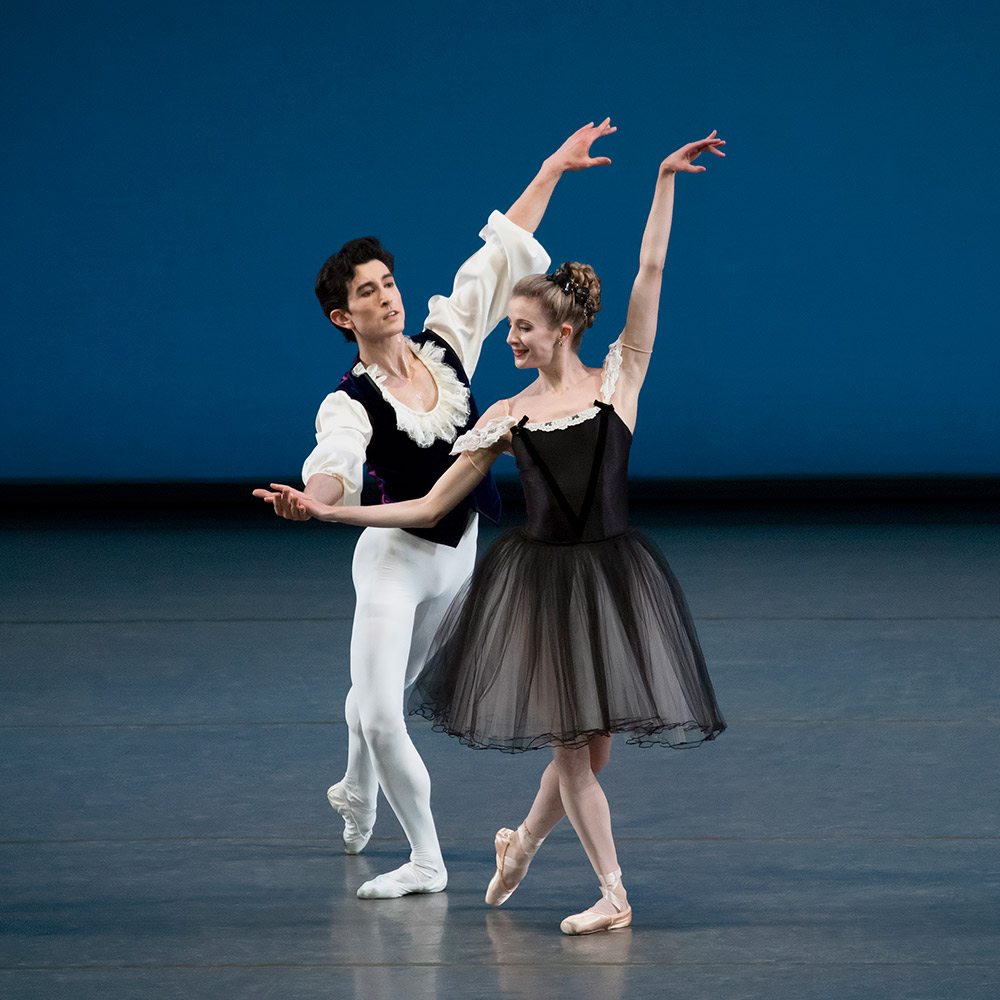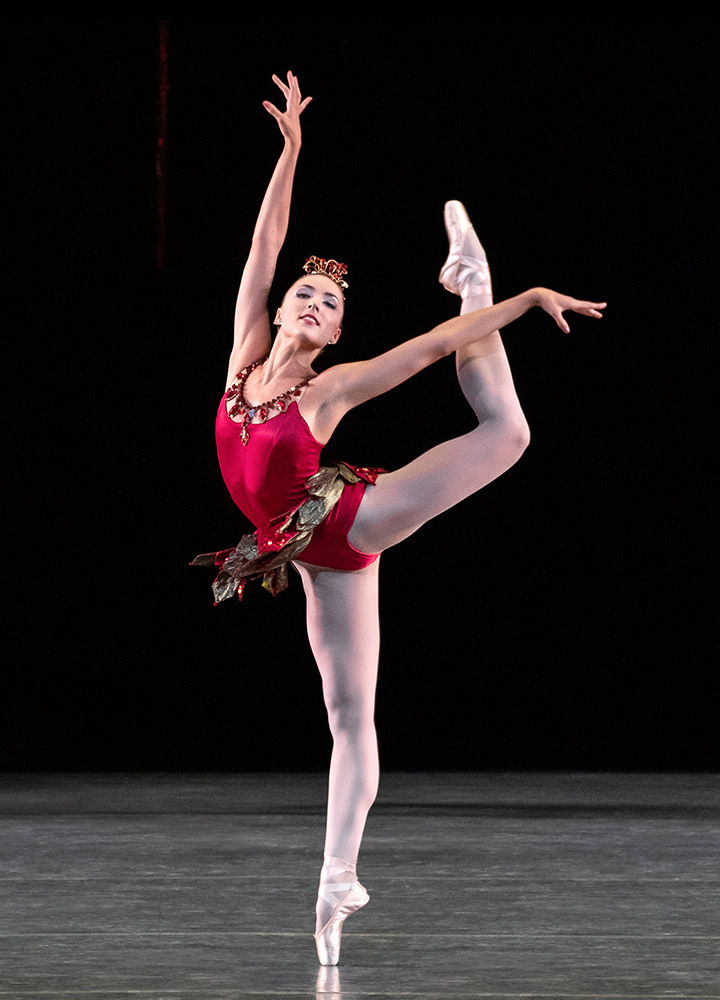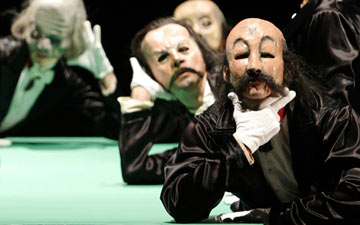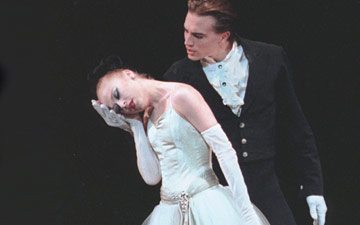
© Erin Baiano. (Click image for larger version)
New York City Ballet
All Balanchine: Mozartiana, Rubies, La Valse
★★★✰✰
New York, David H. Koch Theater
28 November 2021
www.nycballet.com
davidhkochtheater.com
Balanchine Triple
It seems fitting that my final review for DanceTabs (which is about to close to new reviews) should be of a Balanchine triple bill at New York City Ballet. My first, a decade ago, was of La Bayadère at the Paris Opera. Bruce Marriott, the indefatigable founder and editor of DanceTabs, actually bought me that ticket, a typically generous gesture. But New York City Ballet, and Balanchine, has been a constant lodestar of my dancegoing life.
Last week’s performance, of a triple bill of Balanchine works, was as normal as anything could be in these abnormal times. Mozartiana, Rubies, and La Valse were on the program. There were some débuts, including for the rapidly-becoming-essential soloist Jovani Furlan in La Valse. (Promote him!) The theater was not full, but neither was it empty. (Omicron is still around.) A big snowstorm was on the way.
The three ballets were led by veterans. Sterling Hyltin and Anthony Huxley were the lead couple in Mozartiana, with Daniel Ulbricht as the soloist in the stylish gigue. In the Minuet were four of the seven dancers recently promoted to soloist: Ashley Hod, Isabella LaFreniere, Miriam Miller, and Mira Nadon. But even these four, beaming with new confidence, could not bring life to this tiresome minuet, which contains some of Balanchine’s least inspired choreography.

© Erin Baiano. (Click image for larger version)
In contrast, the Theme and Variations section of Mozartiana is one of Balanchine’s wittiest, most luminous creations. Sterling Hyltin and Anthony Huxley danced with individual spark and finesse. Hyltin, as usual, deployed her precise, delicate approach to the steps, showing each one as if holding it under a microscope. Huxley sailed through the intricate male choreography, full of complex jumps and beats that make him appear to hover above the stage like a hummingbird. But there was little chemistry between them, and without that, the dance does not produce the illusion of sparkling conversation as it should. It would be nice to see Hyltin with a more communicative partner.
Rubies, usually performed as part of the full-evening triptych Jewels, was seen here on its own. Emily Kikta, just promoted to soloist, was the Amazonian soloist, kicking her legs forward like javelins to Stravinsky’s jabbing chords, standing sexily and aloofly in profile, the better to show off her silhouette, and diving into perilous penchés. Kikta has the coolness and the power for the role, though not the ironic distance that made Teresa Reichlen such a standout. (It has just been announced that Reichlen will retire on Feb. 19, after a performance of Balanchine’s Swan Lake.) Instead, Kikta plays it straight. She was especially impressive in the final section, where she got to show off her sailing jump.

© Erin Baiano. (Click image for larger version)
Megan Fairchild and Gonzalo García were the playful couple, full of mischief. Fairchild, it must be said, was made to dance this role, to which she brings her comedienne chops and sense of fun. She turns each encounter with her partner into a game – bravely launching herself into off-balance poses with the assurance that he will catch her. Her turns, too, are clean and buoyant and easy. García, handsome and gracious, just manages to keep up with her. (He too retires, at the end of the month.)
The début of the evening was Jovani Furlan’s in La Valse, as the suitor in the ballet’s final section. The role is often danced blandly; he is the man who is abandoned by the heroine for the dark, dangerous death figure. But with Furlan, the story becomes more interesting. He brings a sexy stylishness to the role – especially in the way he uses his hands and his eyes – that creates a certain tension. The woman has a real choice to make. The woman in question was Sara Mearns, imposing as always, dancing with heedless glee, throwing herself into the arms of death (Amar Ramasar) hungrily. Vanity, she makes it clear, is the lure that draws her in. Earlier in the ballet, Ashley Laracey, as the ingenue who turns out to be slightly less innocent than she at first appears, was delicate one moment, capricious the next.

© Paul Kolnik. (Click image for larger version)
As always, I was struck by the ballet’s cold heart, the way it holds a mirror to human insincerity and vanity. On the surface, the ballet, like Ravel’s swooping music, is glamorous and grand, but underneath lies an acrid poison. It is Balanchine’s Cloven Kingdom, his Vile Bodies. For all its beauty, it leaves one with an empty feeling at the end.
Not so the end of DanceTabs. To Bruce: chapeau. You have produced an online dance journal of substance and integrity for the last ten years, handsome to look at, informative and well-written. What more can one ask for. (You sweet thing Marina! And thank you – big time. Ed)

















You must be logged in to post a comment.